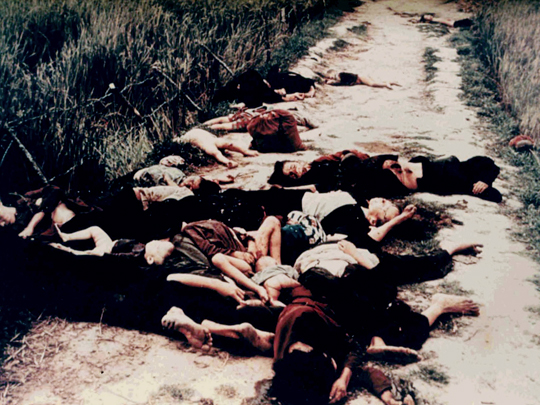By Ronald L. Haeberle / Wikimedia Commons / CC-BY-SA-3.0 / GFDL
1 – My Lai massacre
The My Lai massacre was a mass killing of up to 500 unarmed civilians in South Vietnam on March 16, 1968, during the Vietnam War.
It was committed by U.S. Army soldiers from Company C of the 1st Battalion.
Victims included men, women, children, and infants. Some of the women were gang-raped and their bodies mutilated.
Twenty-six soldiers were charged with criminal offenses, but only Lieutenant William Calley Jr., a platoon leader in C Company, was convicted.
Found guilty of killing 22 villagers, he was originally given a life sentence but served only three and a half years under house arrest.
The massacre took place in two hamlets of Sơn Mỹ village in Quảng Ngãi Province. These hamlets were marked on the U.S. Army topographic maps as My Lai and My Khe.
Along with the No Gun Ri massacre in Korea twenty years earlier, My Lai was one of the largest single massacres of civilians by U.S. forces in the 20th century.
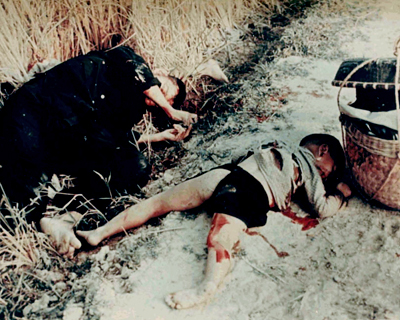
The incident prompted global outrage when it became public knowledge in November 1969.
The My Lai massacre helped increase opposition to the U.S. involvement in the Vietnam War when the scope of killing and cover-up attempts were exposed.
Initially, three U.S. servicemen who had tried to halt the massacre and rescue the hiding civilians were shunned and even denounced as traitors by several U.S. Congressmen.
It was thirty years later before the men were recognized and decorated, one posthumously, by the U.S. Army for shielding non-combatants from harm in a war zone.
2 – Martin Luther King Jr. Assassinated
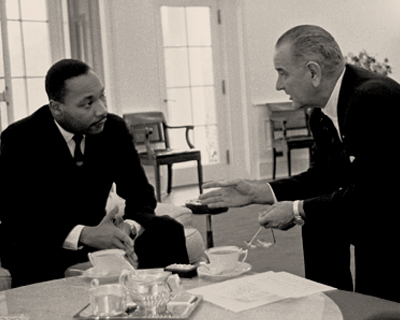
Prominent Civil Right leader and Nobel Peace Prize laureate Martin Luther King Jr. was fatally shot at the Lorraine Motel in Memphis, Tennessee, on April 4, 1968.
King was rushed to St. Joseph’s Hospital, where he was pronounced dead at 7:05 p.m. that evening. He was known for his use of nonviolence and civil disobedience.
James Earl Ray, a fugitive from the Missouri State Penitentiary, was arrested on June 8, 1968, in Heathrow Airport, London, extradited to the United States, and charged with the crime.
On March 10, 1969, Ray entered a plea of guilty and was sentenced to 99 years in the Tennessee State Penitentiary.
Ray later made many attempts to withdraw his guilty plea and be tried by a jury, but was unsuccessful; he died in prison on April 23, 1998, at the age of 70.
The King family and others believe that the assassination was carried out by a conspiracy involving the U.S. government, as alleged by Memphis restauranteur Loyd Jowers in 1993, and that Ray was a scapegoat.
In 1999 the King family filed a wrongful death lawsuit against Jowers for the sum of $10,000,000. During the trial, both the family and Jowers presented evidence alleging a government conspiracy.
The government agencies accused could not defend themselves because they were not named as defendants. The jury concluded that Jowers and “others were part of a conspiracy to kill King.”
The allegations and the finding of the Memphis jury were later rejected by the United States Department of Justice in 2000.
3 – Bobby Kennedy Assassinated by Sirhan Sirhan
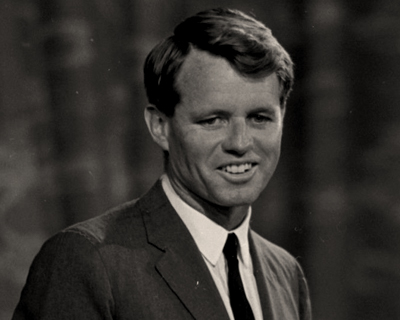
The assassination of Robert Francis “Bobby” Kennedy, United States Senator, and brother of President John F. Kennedy took place shortly after midnight on June 5, 1968, in Los Angeles, California.
His shooting occurred during the campaign season for the 1968 presidential election, moments after winning the California and South Dakota primary elections for the Democratic nomination for President of the United States,
Kennedy was fatally shot as he walked through the kitchen of the Ambassador Hotel and died in the Good Samaritan Hospital twenty-six hours later.
Sirhan Sirhan, a 24-year-old Palestinian/Jordanian immigrant, was convicted of Kennedy’s murder and is serving a life sentence for the crime.
The shooting was recorded on audiotape by a freelance newspaper reporter, and the aftermath was captured on film.
Kennedy’s body was interred near his brother John at Arlington National Cemetery. His death prompted the protection of presidential candidates by the United States Secret Service.
Hubert Humphrey went on to win the Democratic nomination for the presidency but ultimately lost the election to Republican Richard Nixon.
As with his brother John’s death, Kennedy’s assassination and the circumstances surrounding it have spawned a variety of conspiracy theories.
Kennedy remains one of only two sitting United States Senators to be assassinated, the other being fellow Democrat Huey Long in 1935.
4 – Tommie Smith & John Carlos Give Black Power Salute
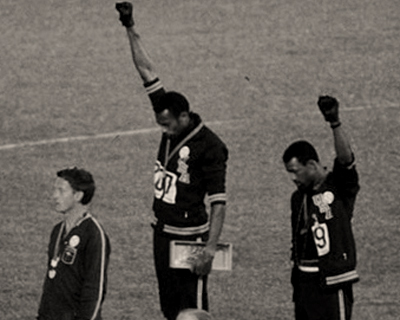
The 1968 Olympics Black Power salute was a political demonstration conducted by African-American athletes Tommie Smith and John Carlos.
It took place during their medal ceremony on October 16 at the Summer Olympics in the Olympic Stadium in Mexico City.
After having won gold and bronze medals, respectively, in the 200-meter running event, they turned on the podium to face their flags, and to hear the American national anthem, “The Star-Spangled Banner”.
Both American athletes raised a black-gloved fist and kept them raised until the anthem had finished.
In addition, Smith, Carlos, and Australian silver medalist Peter Norman all wore human rights badges on their jackets.
In his autobiography, Silent Gesture, Smith stated that the gesture was not a “Black Power” salute, but a “human rights salute”.
The event is regarded as one of the most overtly political statements in the history of the modern Olympic Games.
5 – Apollo 8 Became the First Manned Spacecraft to Leave Earth’s Orbit & Return Safely
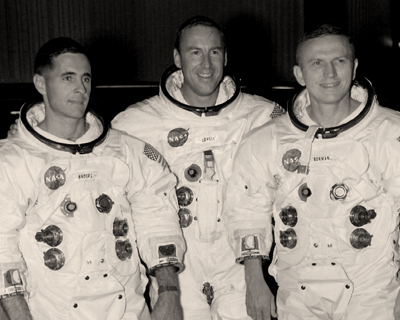
Apollo 8, launched on December 21, 1968, and became the first manned spacecraft to leave Earth orbit, reach the Earth’s Moon, orbit it and return safely to Earth.
The mission was also the first human spaceflight launch from the Kennedy Space Center, Florida, located adjacent to Cape Canaveral Air Force Station.
The three-astronaut crew was Commander Frank Borman, Command Module Pilot James Lovell, and Lunar Module Pilot William Anders.
They became the first humans to travel beyond low Earth orbit, the first to see Earth as a whole planet, the first to directly see the far side of the Moon, and then the first to witness Earthrise.
Apollo 8 took three days to travel to the Moon. It orbited ten times over the course of 20 hours, during which the crew made a Christmas Eve television broadcast where they read the first 10 verses from the Book of Genesis.
At the time, the broadcast was the most-watched TV program ever.
Apollo 8’s successful mission paved the way for Apollo 11 to fulfill U.S. President John F. Kennedy’s goal of landing a man on the Moon before the end of the 1960s.
The Apollo 8 astronauts returned to Earth on December 27, 1968, when their spacecraft splashed down in the Northern Pacific Ocean. The crew was named Time magazine’s “Men of the Year” for 1968 upon their return.
6 – Northern Ireland’s First Civil Rights March Held
On 27 April 1968, the Northern Ireland Civil Rights Association (NICRA) held a rally to protest the banning of a Republican Easter parade.
On 24 August 1968, the Campaign for Social Justice (CSJ), NICRA, and other groups held the first civil rights march in Northern Ireland from Coalisland to Dungannon, in County Tyrone.
Loyalists organized a counter-demonstration in an effort to get the march banned and in fact, the rally was officially banned.
Despite this, the march took place and passed off without incident.
The publicity surrounding the march encouraged other protesting groups to form branches of NICRA.
7 – Battle of Khe Sanh during the Vietnam War

The Battle of Khe Sanh was conducted in Khe Sanh of northwestern Quảng Trị Province, the Republic of Vietnam, between 21 January and 9 July 1968 during the Vietnam War.
It was fought between U.S. Marines, US Seventh Air Force, other US forces & minor elements of the South Vietnamese Army against the North Vietnamese Army (NVA).
The Americans initially believed that combat operations around the Khe Sanh Combat Base during the summer of 1967 were just part of a series of minor North Vietnamese offensives in the border regions.
That appraisal was altered when it was discovered that the NVA was moving major forces into the area during the autumn and winter.
A massive aerial bombardment campaign (Operation Niagara) was launched by the U.S. Air Force to support the Marine base.
Over 100,000 tons of bombs (equivalent to five Hiroshima-size atomic bombs) were dropped onto the area surrounding Khe Sanh.
This was roughly 1,300 tons of bombs dropped daily. In addition, 158,000 large-caliber shells were fired on the surrounding hills.
In March 1968, an overland relief expedition (Operation Pegasus) was launched by a combined Marine–Army/South Vietnamese task force that eventually broke through to the Marines at Khe Sanh.
On 19 June 1968, ‘Operation Charlie’ began at Khe Sanh, the final evacuation and destruction of the Khe Sanh Combat Base. U.S. Marines withdrew all salvageable material and destroyed everything else.
The NVA continued shelling the base, and, on 1 July, launched an attack against its perimeter. On 9 July, the flag of the Viet Cong was set up at Khe Sanh airfield.
On 13 July, Ho Chi Minh sent a message to the NVA soldiers affirming their victory at Khe Sanh.
It was the first time in the war that the Americans abandoned a major combat base because of enemy pressure.
